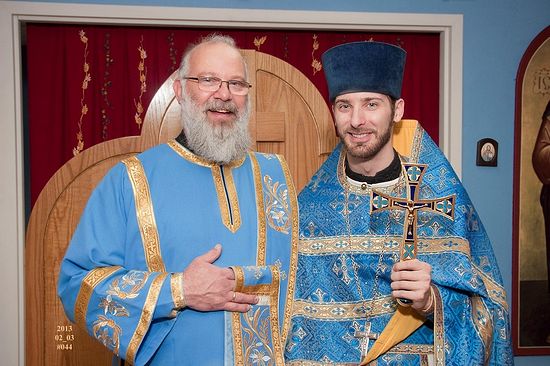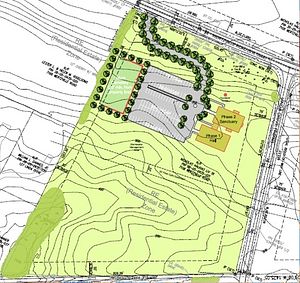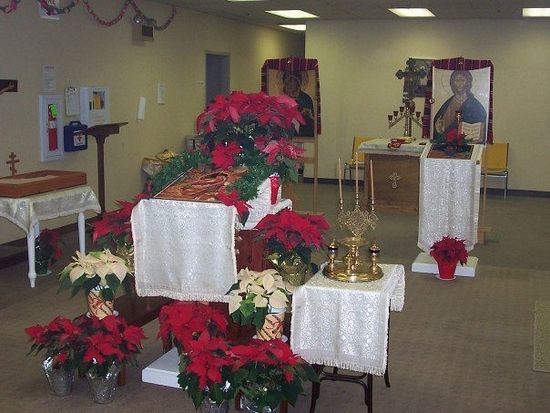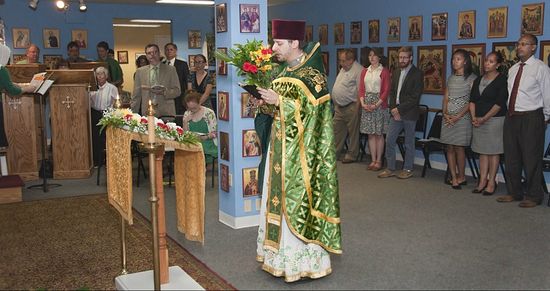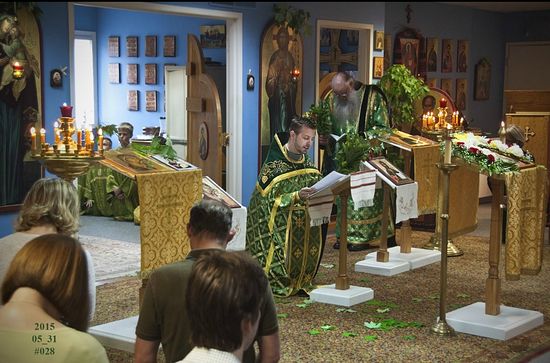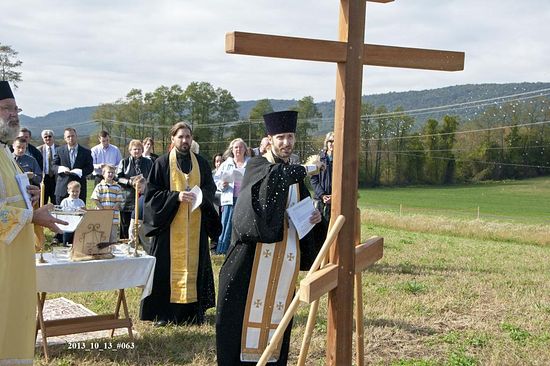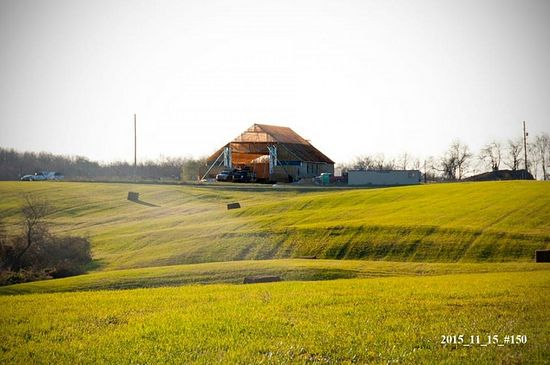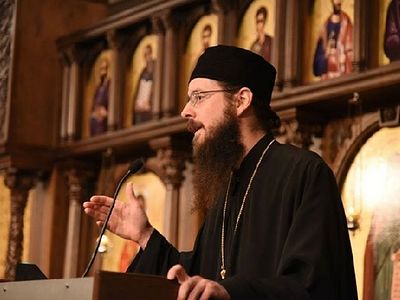Pennsylvania has a rich Orthodox history. There are presently five monasteries, two seminaries, and hundreds of parishes throughout the cities and dotting the countryside. Western Pennsylvania was heavily populated by Eastern European immigrants coming to work in the steel mines, and the Pittsburgh area alone has more than 100 Orthodox parishes. Likewise, Eastern Pennsylvania is full of Orthodox parishes where immigrants worked in the coal mines. Unfortunately, today, many of these parishes are dwindling as work, and consequently the youth, have left these areas, and as the country continues to move in a secular direction.
Thankfully, there are cases to the contrary. The mission of the Holy Apostles (OCA) in Mechanicsburg, PA is one such exception. It was founded in 2004, and Fr. Timothy Hojnicki arrived in 2005. They were worshiping in a rented warehouse space, and eighteen months later found the building they are currently in. They knew then that it was not the final product but only a stepping stone, with the blessing of then Bishop Tikhon (now the Metropolitan) they moved in in January 2007, and until now they have grown faster than expected, which is, of course, a good problem to have.
Mechanicsburg is a city of around 9,000, situated just eight miles west of the state capital, the city of Harrisburg, in southern Pennsylvania. While boasting a small population, the city is heavy on business and is rapidly growing. Additionally, it is situated in a rich agricultural region known as the Cumberland Valley, near the Ridge-and-Valley Appalachians.
Fr. Timothy sat down with OrthoChristian.com to share with us some history of the mission parish, as well as his reflections on the work of a mission priest and parish, and the current state of the Orthodox Church in America (OCA).
* * *
—Father, tell us a little bit about your current building project.
—A couple of years back we started a “vision committee” to see what are the needs of the parish and it started like the Great Litany—“for the peace of the whole world,” and then we narrowed it down to us—we want a school and a hospital and this and that, but ok, to get to that we need to start with a church. One of things that came up was that the parish wanted a cemetery because we have a lot of people that don’t have Orthodox families and they need a place to be buried, and a lot of young people who haven’t thought about it yet, so we needed enough land for a church that we could put a cemetery on. We decided we wanted our own building and not to convert another church, so we started looking.
A friend of ours from the Greek cathedral introduced us to a man who was selling off a huge section of land and through his help we acquired 13.6 acres on the edge of Mechanicsburg from this man at a discounted price. Because Mechanicsburg is everywhere built up, there are really only two places where it can grow, and this is one of them. In the next twenty years it’s going to be in the middle of everything, but now it’s in the middle of a cornfield. It’ll be nice to see it as it develops. We decided to build a hall first that had a chapel, three classrooms, and a kitchen, and then eventually when we have a financial base we’ll build the temple next door, knock down the division wall and the whole thing will become the church. The tag line for this whole project has been, “and this building—not the church” because we don’t want anyone to think this is the final product. That is why there isn’t a gigantic dome and it’s not in cruciform—I didn’t want it to look like a church because then we’d get comfortable and stay there. I want it to be nice but to realize we have to move. So there’ll be a little dome that will go in the front of it so it looks churchy enough but not too churchy to stay a church. Even when we have meetings about it now at coffee hour someone will be talking about that building and someone will yell out, “not the church!”
It’ll hold about 175 in the nave, and that will be the trigger to start working towards the actual church building. The plan is to have the building connected by a breezeway, so you won’t have to take your jacket off to get to the hall, so people will stay. And the cemetery will be directly facing you when come out of the church, so you’ll have a Cross facing you, reminding you of where you’re going to end up. The cemetery will be cruciform, with a fifteen-foot three-bar cross with a canopy above it in the middle on a platform for pannihkidas. There will be four sections, named for Matthew, Mark, Luke, and John. One section will be for clergy, and there will be a section for children and miscarried infants. We’re not selling graves—it will be a ministry of the parish. We had some older immigrants come over and didn’t know what they would do when they die. We don’t want burial to be a worry for our parishioners; we’re going to take it on as a ministry of the parish. We’re also looking at very traditional burial practices, like those discussed in the book, A Christian Ending—the way it used to be done.
This first stage of the project should be done by Christmas time, and we’ve projected that in ten years we will start looking at the actual, traditional temple. Everything won’t be perfect, on purpose. There won’t be running water in the altar—I want the boys to have to run to the kitchen to get it. I didn’t make the hall spacious because we want it to be already tight, so that we’ll know we need to build again. Once the wall comes down the whole thing will open up and we’ll have a huge hall eventually.
So, that’s the vision for going forward. I came here in 2005, and it is now 2015. It’s been a decade of advancing little-by-little.
—It’s taken a decade to get to this point and you’re projecting another decade still. Is it hard to be that patient?
—Yes!
—That would drive me crazy. You’ve got this vision, but it’s going to take a while.
—His Beatitude Metropolitan Herman has been my bishop since I was a kid, so he knows my personality. He thought it would be a good fit for me to come to Mechanicsburg, because I’m not a patient person; I think it was also an obedience to come here and learn patience, because that’s also part of the deal. The church I was serving at in Olyphant before I came here was a beautiful church with a fantastic choir, 30 foot iconostasis, great acoustics, every liturgical instrument you could want—the whole nine yards. And then I came to Mechanicsburg and my first Sunday was in a dusty warehouse lobby. I had to bend my chalice back into place before I could use it for the first time. The censer had half its bells missing, the robes were all torn—and I thought to myself, “What is this?”
I joke that on my first Sunday there, on Pentecost, the reader read the wrong epistle, and I had prepared my sermon on the right one, and one of the parishioners gave me a bouquet of flowers form their garden, but the ants from the bouquet were eating my hand during the sermon. There’s a picture of it in which you can see this blank look on my face and I’m thinking: “This guy’s reading the wrong epistle, and ants are biting my hand. What have I done? Why am I here?!”
—That’s a good start!
—I tell people all the time that after that first Liturgy my pregnant wife and I came home and just cried. But now ten years later it’s paradise and I wouldn’t go anywhere else. We’ve become a family.
—So 175 is the limit for the first phase of the new building. How many people did the parish have when you showed up?
—The first Liturgy for the mission had twenty-two souls. I got there a year later and it was up to forty. People just came out of the woodworks—either they had stopped going to church or were going to other places—but there was this impetus to come to church. And now we officially have ninety-six adults and forty or more children, so that’s a decent group.
About two thirds of the congregation are converts, and so a lot of the people already understood Christian giving—tithing; so that’s why we can afford to pay a full-time priest and build a building at the same time, with all the other stuff. And as we projected, as long as we continue to grow we can sustain it.
Fr. Eric Tosi, the secretary of the Orthodox Church in America, did his doctoral thesis on evangelization methods in the Orthodox Church and we were one of three churches that were case studies. One church was older and established, one was middle-aged, and one was a mission, all in different parts of the country and he studied how they’ve grown. And basically we break all the rules of evangelization and growth in church groups. You can’t find it, you can’t see it, we don’t look like a church, there’s no signage, but yet it grows. So the hope is that if we put this 7800 sq. ft. building on top of a hill in the middle of a thirteen acre plot on a road that thousands go on every day with a dome on top and a sign, “come and see,” then many more will come to the Church.
We’re going to start using more of the things God has blessed us with. Our choir is going to give some public concerts. We want to have some community dinners with no catch just to get people in the door and expose them. They can just come and eat our food and be with us, and maybe the choir will sing something. This is an area where the Church has not yet been with an established parish. It’s a nice area because it’s small enough that you can get to know people, but not too small. At first I don’t think people knew what to think of me. Maybe they thought I was someone out of a Harry Potter movie, walking around with a cassock on, but now they understand that I’m just the local Orthodox priest.
One of the things we’ve done is to start a monthly charity. We’ve given to International Orthodox Christian Charities, the Orthodox Christian Mission Center, St. Tikhon’s and so on, but we usually give to charities in Mechanicsburg so the Church will be known for what it gives rather than for what it takes from the community. The Church used to be the administrator of philanthropy, not the recipient of it. It’s neat when you see someone on the street and they say, “Pastor, your church gave this donation to my mom’s friend and we really appreciated it.” Giving to the community creates a good connection, and God has blessed us with very generous people.
—Has there been any more overtly Orthodox outreach that says, “We are Orthodox. Come and see!”
—The parish has had a booth at Jubilee Day, which is the largest one-day street fair on the eastern seaboard, with 60,000 people coming down Main Street. It’s good to have a presence there to give an opportunity for some worthwhile discussion.
I haven’t as much recently, but I used to go to Messiah College regularly to give presentations and celebrate services on campus. The first time I went they wanted me to serve a Liturgy, but they said I had only forty-five minutes, and no other Orthodox would be coming. I told them we couldn’t have a Liturgy but we could do something else. We’ve had Vespers, Compline, Matins or Molebens a few times, just to expose them to Orthodoxy a little bit and give a religious talk afterwards.
At Messiah there are what they call “chapels”; there is a religious theme of the week, and different chapels have different activities about the theme. The first time I was invited to speak, the theme was “human sexuality”, and I knew that could be interesting with a bunch of college kids. When I arrived they saw a guy in black and they immediately rolled their eyes, so I said “To begin with, just so you know, I’m married and have a kid on the way, so let’s start.” That diffused everything and then we were able to talk about it. I’ve given three or four presentations there. One of our parishioners who used to be a professor of Biblical Studies gives presentations, and I give presentations on Orthodox Scriptural interpretation.
We’ve had several converts form the college. We have a ministry to pick people up from Dickinson and Messiah Colleges to make sure they can get to church.
—Is there an OCF[1] at these colleges?
—We started one at Messiah that had about four people, but it quickly faded out in the first year. It’s still there, it’s open, so we’re going to try again this Fall and see what happens. Working with college students is probably one of the most frustrating parts of my ministry. Some people really love it, but I struggle with it because it’s so fluid. You can have a strong group one year and then everyone graduates and you’re back to square one. But it’s a good and worthy ministry, so we’re plugging along.
—Our OCF struggled at Penn State University as well. We would get a list of students who identified themselves as Orthodox. There were probably a few hundred of them, and a lot of them were ethnic Orthodox. We always wanted to get them to show up to our events, but us converts didn’t know how to reach out to the Greeks or Russians.
—Our group had a few Greeks, but they tended to go home a lot on weekends. The group is there but we have some work to do to make it better known. It is a work in progress.
—What would you say to other mission priests who are just starting out?
—Patience. When I came here, the mission already had forty adults and it was already firing on all cylinders. I liken it to an old-fashioned stage coach where you have to pull the reins back because the horse is going crazy—they’re so excited and trying to do everything all at once, and I have to say, “Whoa, whoa!”
I asked my father-in-law what to do. He was the founding dean of St. Innocent's Cathedral in Anchorage, AK. He got off the plane in 1967 with basically a few addresses and was told to “go build a church.” He told me, “First, you must love your people.” I thought that was obvious. But the God’s honest truth is that if you convince them you love them, they’ll do anything for you. People call me randomly and say, “Father, drop off your kids. You need to take your wife out on a date.” It works great when you have a project like this. We needed $1.5 million for the loan. I presented it to my parish family and said that as the father of the community, I think we should do this—it’s time, it’s important. They unanimously voted in favor! We decided to buy the land by a unanimous decision, and we applied for the loan by a unanimous decision.
Archbishop Tikhon at the time said to make sure it’s not just a majority, but an extreme majority, because we want the people to sustain this project. We don’t want just half of them upholding everything. When we had a unanimous decision I even audibly exclaimed at the meeting, “Really?!”
—Who has ever heard of a unanimous decision in an Orthodox parish?
—We talk about it every week and give people updates and encourage them to go see the building’s progress so they feel involved.
I told them to say “yes” only if they wanted it and were willing to support it, and not because I wanted it. We calculated out that if everybody increased their giving by a certain amount we wouldn’t have to do a single fundraiser—no pirogis or anything. We just build the church. Not that fundraisers are bad things, and money might get tight and we might have to do that, which is fine, but I don’t want someone else to pay for my building. I don’t ask my neighbor to pay for my electric bill. My wife and I sit down and figure out what we have to do, and we tighten our belts and we do it. It will be the same thing for the church.
—Some churches would go under if they weren’t pinching pirogis.
—That’s the thing—I don’t want it to be a crutch. We have one fundraiser a year—a dinner dance in the fall, but it’s not part of the budget. The money goes to the building fund, not to the operating costs of the church. My vision is that eventually when we pay this off and we’re more established, we’ll still hold the dance, and half will go to upkeep for repairs, half will go to charity—every year.
—Agia Sophia[2] works that way too, right—a large part is given to charity?
—Every month a charity in Harrisburg is chosen.
—You taught at the mission conference in the Midwest, correct?
—Yes, at the OCA’s mission school that started this past year. Basically, clergy from across the country come together to learn from each other. This year they asked priests who have gone through the mission planting grant program to offer their experience. I was chosen to give my presentation on how to celebrate the services with minimal liturgical supplies. Only God makes things ex nihilo; however, we can take all kinds of things and decorate a church. I could go to a Big Lots store and deck out a church—you just have to know what you’re looking for. My son was baptized in a bucket from Wal-Mart. We have a traditional font now, but we joke that he was baptized in a blue bucket.
—The All-American Conference was on expanding mission. You and many others said they had a very positive feeling about it.
—His Beatitude Metropolitan Tikhon gave the address the first day and set the tone for how things would go. He offered his vision for the Church, and it was very inspiring. Met Tikhon definitely prepared that address. It was masterful. He weaved in personal stories, Church fathers, as well as more secular things, but it all worked together and really inspired people. And the good feeling isn’t just because we passed the financial resolution and statute revision, but we also raised $17,000 for Syria from the floor of the council for IOCC[3] on a whim. Buckets went out and people started throwing in money. It wasn’t just theory but also practice.
The whole spirit was different. I’ve been to several AACs and sometimes they’re heated—there’s a feeling of “them” and “us.” There was no feeling of this. We were all on the same page. The OCA has had its struggles, but if you know Church history it’s nothing new. Some people criticize the OCA because we have so many retired metropolitans. Ok, look at the history of Russia and how many times the Patriarch was deposed and the metropolitan was deposed, and this tsar overthrew that one.
—In Constantinople too.
—Yes, it’s our history. It’s just what happens. It’s not ideal, we don’t rejoice in it, but it’s not the end of the world either. The Church goes on. That’s the beauty of Orthodoxy—it has these internal mechanisms to correct itself and get back on the rails. St. Basil the Great has a great quote: “The whole world groaned and realized it was Arian”.[4] The whole world! It’s an exaggeration, but if we dealt with that and got back on track, this is nothing.
—Would you say, in general, you’re hopeful about the future of Orthodoxy in America?
—I think Fr. Seraphim Rose was spot on when he said that if Orthodoxy is going to survive here it has to be more about Orthodoxy and less about the American spirit, because the spirit of Orthodoxy and the spirit of America are sometimes completely diametrically opposed. Me, me, me; life, liberty, and the pursuit of happiness is all fine—but we’re not about the pursuit of happiness in the Church. We’re about the acquisition of joy in the Holy Spirit, life in Christ; it’s not all about my rights. There’s a dominant feeling in the American spirit of the corporate ladder and stepping over the other guy to get where you want. Humbling yourself doesn’t even fall on the radar. I think that’s much of the struggle we see in our parishes—people are more American than they are Orthodox.
There’s always hope. We’re the eternal optimists. Good Friday was awful. Christ was arrested, betrayed, killed, His Apostles scattered and they thought, “Oh, this is horrible.” And that event redeemed the whole world. Hindsight is 20/20. Even when things are difficult there’s always hope—it’s just a question of how do we sustain it, and convey it to the people.
—It can be hard. Fr. Alexander Atty always talked about trying to re-missionize the NEPA Valley with all these dying parishes full of old women.[5] What do we do?
—It’s true, but at the same time these people, during the Depression, built these magnificent structures. They worked in the mines all day and with their sustenance they built these churches—during the Depression era! That has to be worth something. Granted, I don’t know how much of that was passed down to their children and their children’s children.
Have you read that book Beauty for Ashes?[6]
—Yes.
—Beautiful! That diocese was in terrible shape, but by the presence of that archbishop and the priests going out to teach people, they transformed it. We’re not that far gone. I just think our people need a reminder of what this is. That’s why when I go out to places I don’t just preach about the Theotokos, icons, podobens,[7] and such things. I love that stuff, but I start with our message of salvation, hope and joy—because without that the rest of the stuff is irrelevant. Without the message of salvation you will not be able to rejoice in the rest of it. Christ has come into the world to save us. When we have friends that are suffering or sad or mournful, we must convey to them the joy of the Resurrection—that’s what we’re called to do. If you can’t do that, then just shut the doors. Start with the basics.
Christ healed the blind man who then wanted to come with Him, and He said, “No, go back to your family and friends and tell them the good things God has done for you.” I think that’s where we should start with evangelism—tell your family and friends what good things God has done for you. And your life had better reflect that. Everybody says that Francis of Assisi says “Preach the gospel at all times and when necessary use words,” but it was actually St. John Chrysostom who said it first. Preach the Gospel always, use words if necessary. We don’t have to talk about it, just live it. In the early Church they could pick out Christians in the marketplace just by how they interacted with one another. Now we’re known for our blue domes and our pirogi recipes. We’ve come a long way from where we’re supposed to be.
—A few months ago we interviewed Fr. Irenei Steenberg, and we talked about this idea of preaching the Gospel and when necessary using words. Of course it’s true that we have to live the Christian life in order to be an evangelist, but he said that sometimes we use this line as an excuse not to talk about Orthodoxy.
—Yes. My grandmother told a great story. One time a man came up to her in the mall and said, “Ma’am what do you believe?” At first she just froze, but then she just said what she knew: “I believe in one God, the Father Almighty, Maker of heaven and earth…” and the guy said, “Nevermind,” and walked away. But that’s why we have that. Start with that. If that seventy-year-old lady can do it, why can’t all of us do it too?
God has blessed our community with many gifts and talents, with good people, and with a faithful witness. The majority of the people who come to the Church did not come there through me at all. Parishioners invite family and friends to Church; they come for a while, and then they tell their family and friends, and so it self-replicates. Go out, pull in, go out, pull in. It’s like being in the boat and just catching the fish that jump in the boat. I probably should do more on the street, although I’m kept pretty busy with just the fish who are jumping in the boat.
—With God’s help you do what you can.
